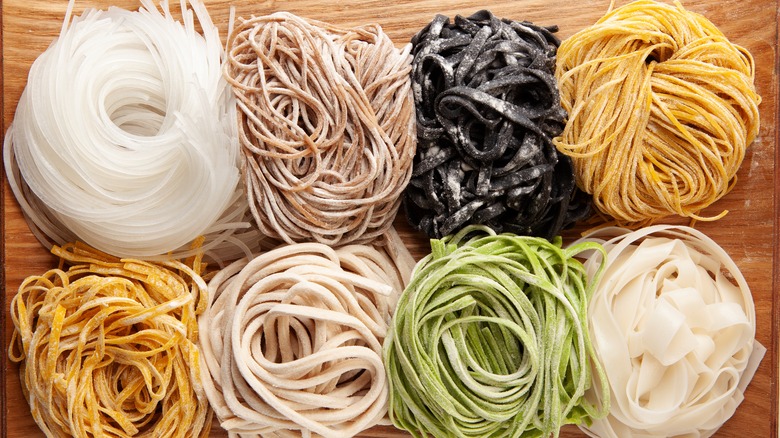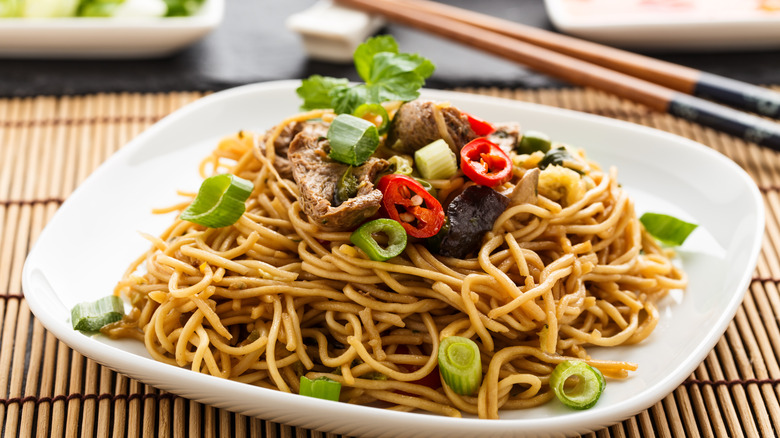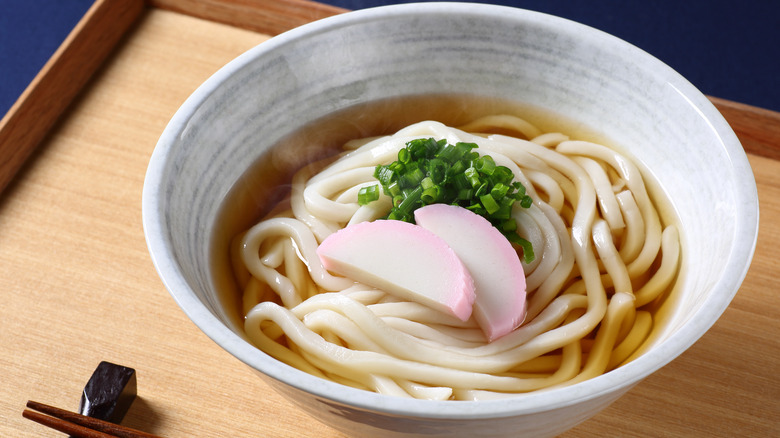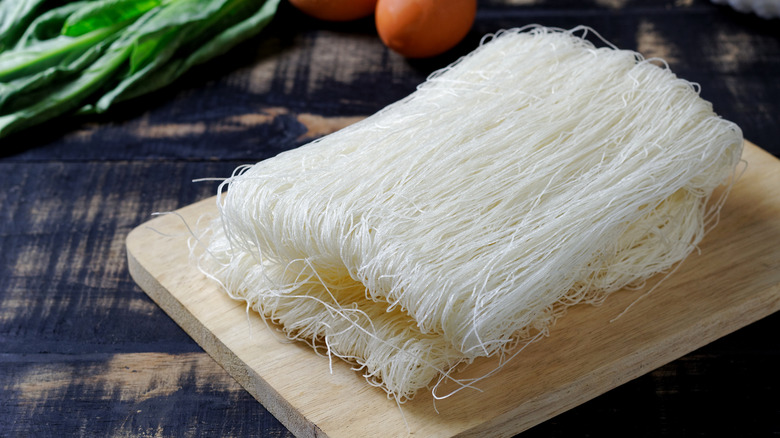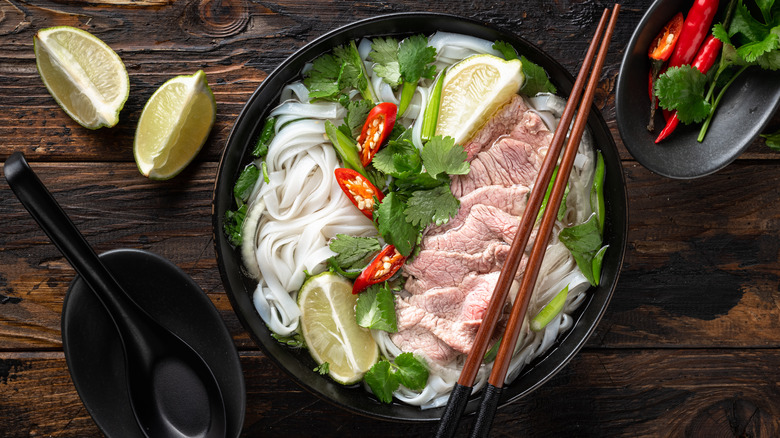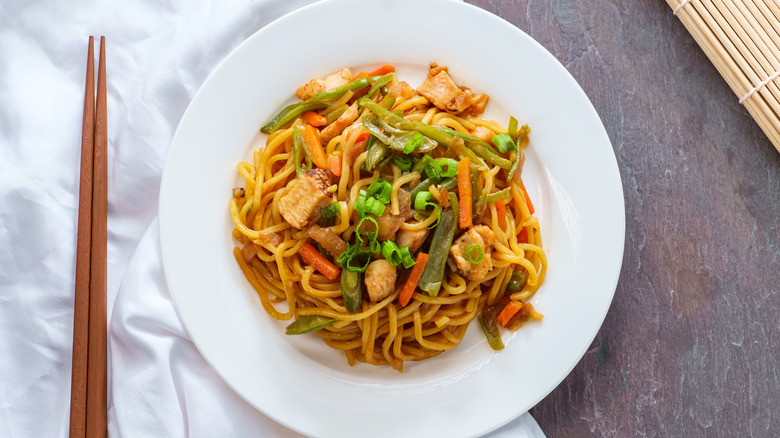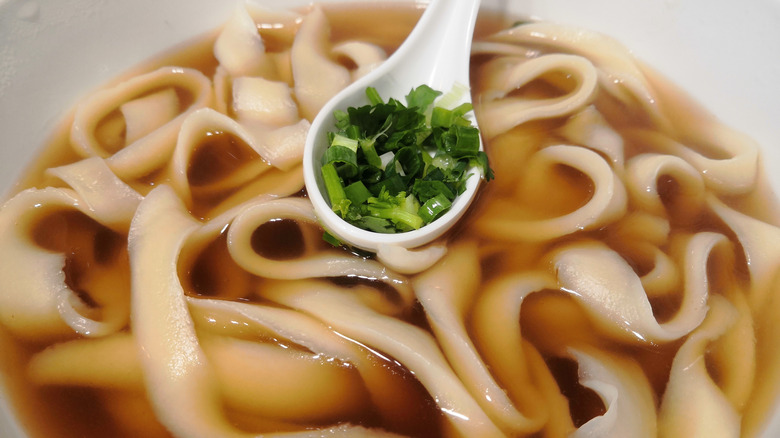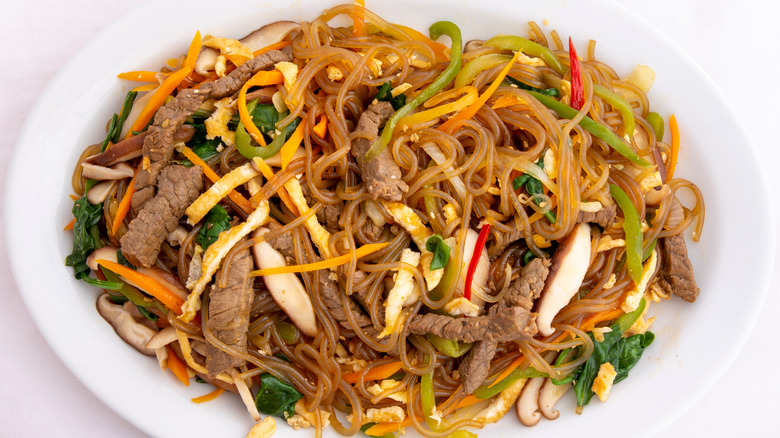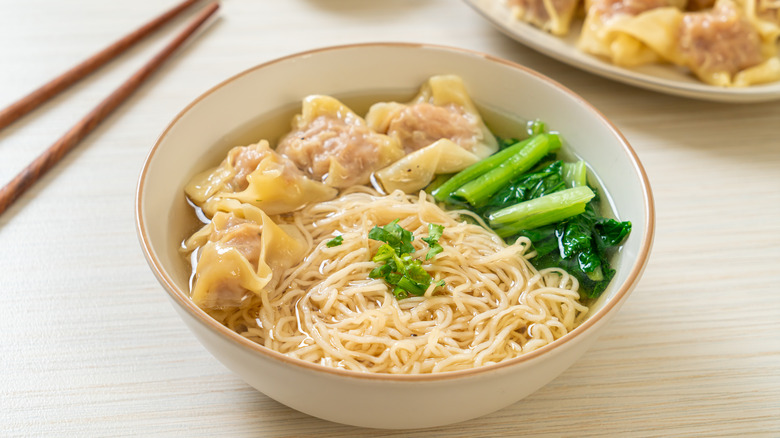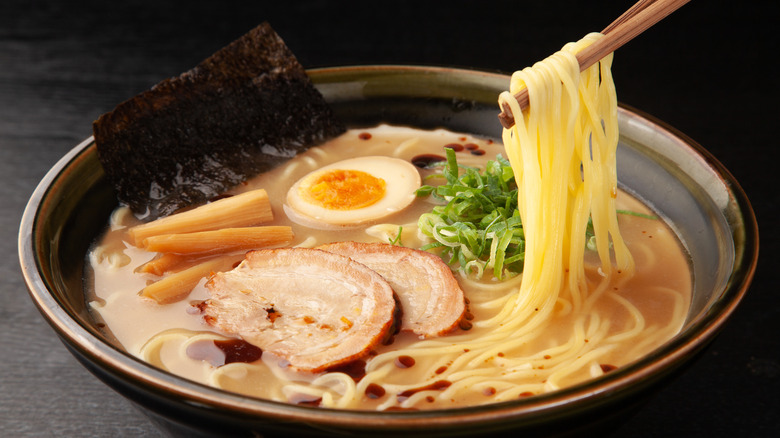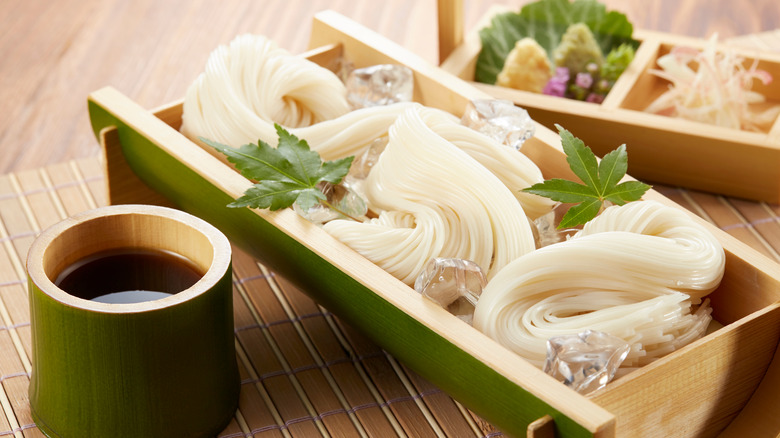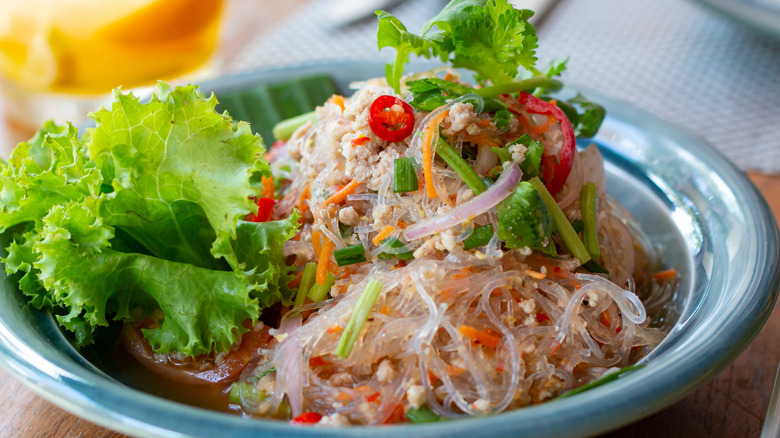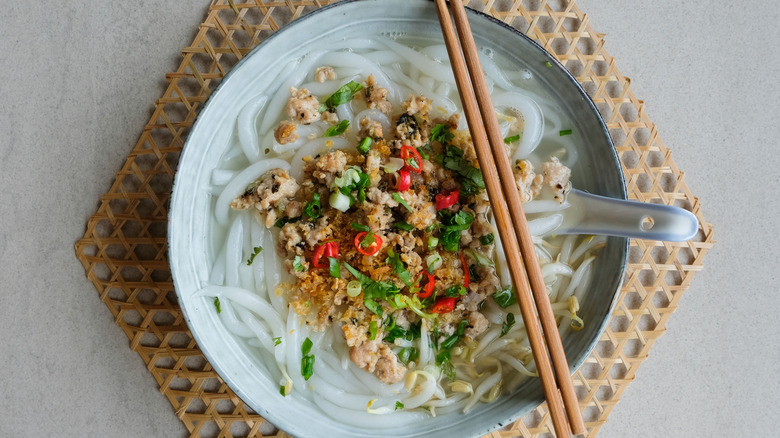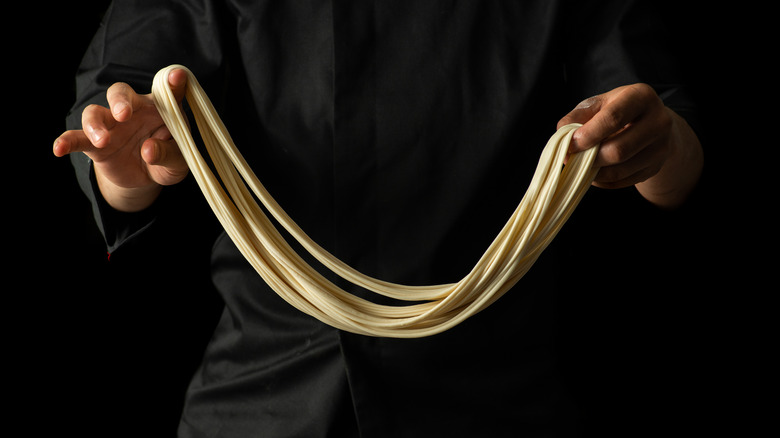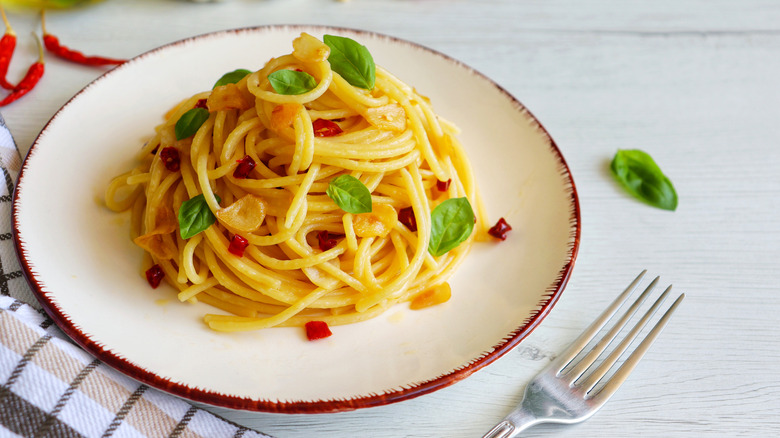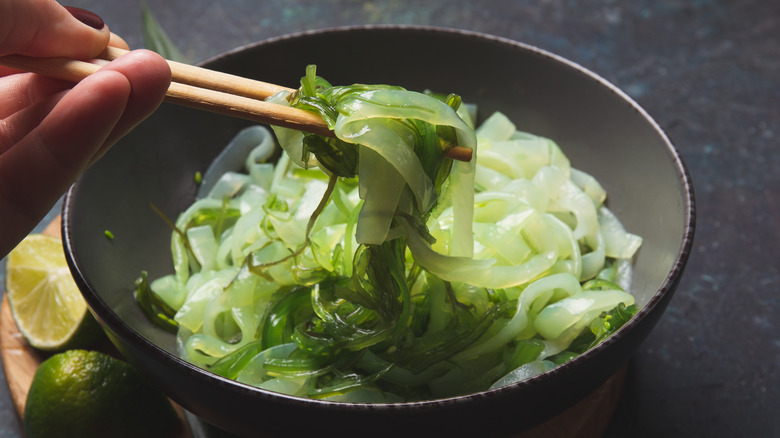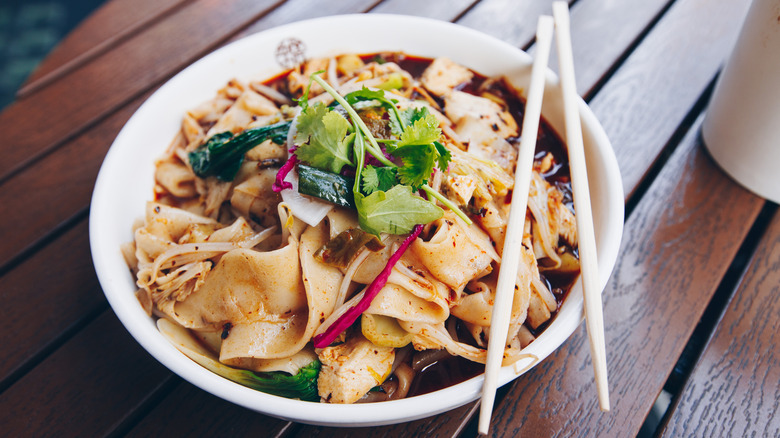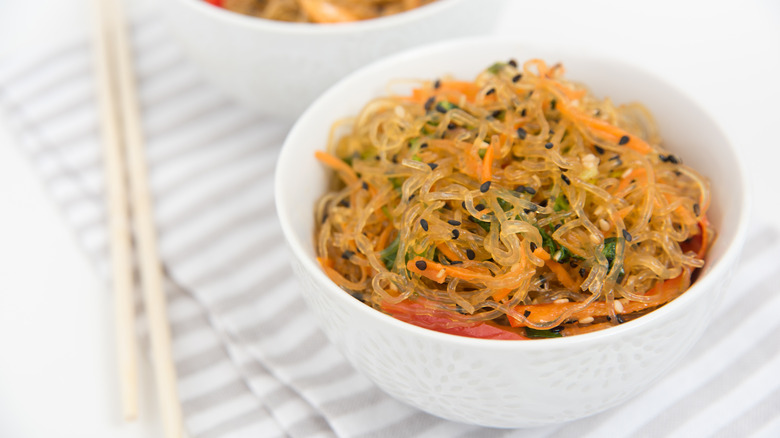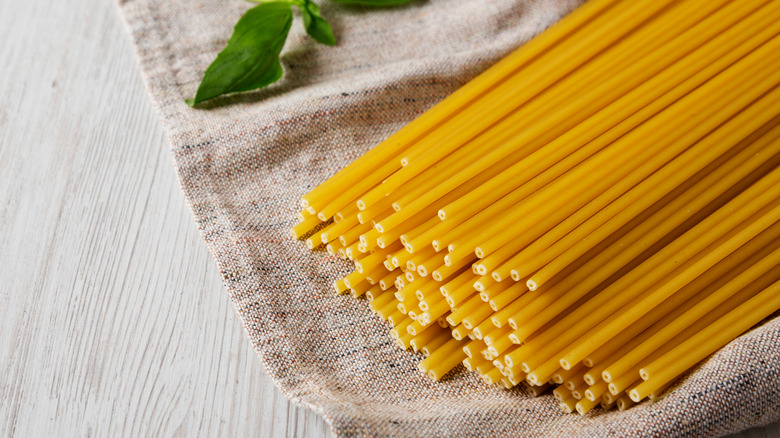20 Different Types Of Noodles Explained
There's something so appetizing about their long, dangly shape and ability to pair with countless sauces, soups, and assorted ingredients. We're talking about noodles of course! While Italians have ownership of pasta and its various renditions, the expansive cuisine of the Asian continent is your source for an endless selection of noodles. Indeed, according to National Geographic, the most ancient example of noodles was discovered in China, dating back 4,000 years. So you could say this loopy dish has a long history as a popular starchy component of people's diets.
If you're used to considering noodles as one single mono-category, prepare to be astonished by the vast choices available. Different compositions, shapes, lengths, and textures make each type of noodle unique and best suited for a handful of purposes. It's easy to pick up a package of dry noodles and call it dinner, but the craft of noodle-pulling is steeped in tradition and worth discovering.
The range of techniques and styles encompassed in the vast array of noodle dishes is seemingly infinite, and you could do worse than trying to eat your way through this list. If you love your food long, slippery, and capable of being swirled, then you had better stock up on the many variations of this delicious food.
1. Lo Mein & Chow Mein
Both lo mein and chow mein are made with the same type of wheat flour and egg noodles — the difference lies in the rest of the preparation (via Taste Atlas).
Fairly popular in the take-out game, lo mein, meaning stirred noodles, is a popular noodle dish from China's Guangdong province, according to Taste Atlas. Noodles are first boiled, then mixed in with sauce and other ingredients. You'll find add-ins such as cabbage, carrots, mushrooms, meat, and seafood. According to San-J, lo mein's defining element is its a sauciness and rich flavor. Think sesame oil, soy and oyster sauce, ginger, garlic, and sugar. When this savory blend is combined with thick egg noodles, the result is an umami overload — there's nothing subtle about lo mein.
On the other hand, chow mein is made by boiling and then frying the noodles until they are partly crispy (via Taste Atlas). Meat (anything works — chicken, beef, pork, shrimp) is tossed in with crunchy vegetables like bean sprouts, cabbage, celery, and mushrooms. First introduced by immigrants in the 1850s, it's been a popular dish in Chinese restaurants in the U.S. ever since, according to Taste Atlas. Not all chow mein you'll encounter is necessarily authentic, but if you order it in more traditional eateries it should be a good bet.
2. Udon
A Japanese staple, udon noodles are made using wheat flour, water, and salt, and measure between 2 and 4 millimeters in width (via MasterClass). Some are rounded into a thin, tubular shape whereas others lie flat. But they weren't always made this way. According to MasterClass, prior to the 14th century, udon were more akin to a dumpling than a long noodle.
According to HuffPost, it's no easy feat to knead udon dough. LA-based chef Yoko Isassim, who was born in Seki, Japan, tells the outlet that, traditionally, women would knead it with their feet so that they could make use of their body weight to facilitate the task. They would often take it one step further and wear heavy backpacks to add more weight. By the 1960s, machines became the common method of choice for making udon noodles, and Isassi remarks that their popularity increased with production.
Compared with soba noodles, which are also common in Japan, Japan-Guide.com notes that udon are chewier and tend to be white in color. Udon can be served both hot and cold, which makes them common in dozens of preparations. Most simply, they are served with a basic dashi broth, but miso or curry sauce are also readily enjoyed (via MasterClass). Udon suki displays them in a hot pot dish, and yaki udon is a tasty stir-fried meal with vegetables and meat. Japan-Guide points out that regional variations abound, and you can just as easily find them in soup or served with a soy and sesame dipping sauce.
3. Soba
Another Japanese classic, soba noodles are made with buckwheat (soba in Japanese) and often combined with wheat flour as well, ( via This is Japan). Since the ingredients to make soba are so simple, it comes down to their quality. It so happens that water from Kyoto (where they are typically made) is prized for its purity, according to 50 Best. The original version of soba dates back as far as the eighth century, but the modern recipe was likely created in the 16th or 17th century.
Ariko Inaoka runs a family-owned soba restaurant in Japan, and she explains that, traditionally, the noodles were considered to be a "powerful, high-vibration food" used to energize Zen Buddhist monks prior to lengthy fasting or meditations (via 50 Best). It follows that the noodles hold an important place spiritually and are perceived to be balanced and nutritious.
Much like udon noodles, soba is commonly served in both hot and cold preparations. Inaoka describes a typical recipe in Kyoto — seiro — which combines cold soba with wasabi, green onions, and a dashi soy sauce. If you're eating the soba cold, be sure to save the cooking water as a nutritious broth to sip on. Meanwhile, the noodles can be enjoyed kake style in a hot broth. Regional variations abound, and toppings and extras are seemingly unlimited, including tempura, vegetables, seafood, and meat. Inaoka encourages slurping, adding that "it helps you enjoy all the flavors."
4. Mei fun
Mei fun refers to both rice vermicelli noodles and dishes that showcase the thin strands. The delicate, thread-like noodles are made with rice flour and water, and the ingredients are definitely a bonus for anyone on a gluten-free diet, as long as there's no risk of cross-contamination from equipment, The Spruce Eats notes. Although rice vermicelli should really only contain ground rice and water, some recipes add egg, wheat, tapioca, or other starches, so be vigilant if gluten is an issue.
Mei fun is typical in cuisines across Asia, though its roots can be traced back to China a mere 2,000 years ago. The vermicelli is sold dry in nest-like bundles, which simply need to be rehydrated in hot water before they can be incorporated into recipes, according to The Spruce Eats. Because they are so delicate, as they absorb water they soften and develop the perfect amount of chewiness to complement various dishes. Just avoid overcooking them or they'll quickly become mushy and stick together.
The thin noodles are definitely versatile, and you can add them to stir fries, soups, or even served chilled as a salad. According to The Spruce Eats, among the many preparations, Singapore mei fun, which doesn't come from Singapore but from Cantonese cuisine, is a popular option. Rice vermicelli is tossed with curry powder, shrimp, pork, egg, and mixed vegetables, resulting in bright yellow noodles with colorful add-ins. We'll gladly have a taste!
5. Flat rice noodles
Whereas rice vermicelli are thin, delicate strands, flat rice noodles are wider and, per their name, flat. If you've ever enjoyed pad thai, then you've devoured flat rice noodles in the process. Fine Cooking affirms that they are indeed made with rice flour and water, though other ingredients like tapioca or cornstarch are sometimes mixed in to improve the chewiness. Again, if you follow a gluten-free diet don't assume that rice noodles are always a suitable choice.
Since flat rice noodles have a bit more surface area, a simple soak isn't sufficient and you'll actually need to boil them much like pasta (via Fine Cooking). Once they're boiled, you can toss them in a stir fry at the last minute, add them to soup, or serve them chilled for a filling salad. Pho typically makes use of flat rice noodles, and in Vietnam, they are called bahn pho. Andrea Nguyen, author of "The Pho Cookbook," tells LOJEL, "The noodles are tender-chewy and silky. She explains that this allows them to "perfectly convey the flavors of pho broth because of their flatness."
6. Yi Mein
There are plenty of traditions and beliefs surrounding food, and yi mein (also yi mian, e-fu, yi fu) are considered to be longevity noodles, commonly served at Chinese New Year celebrations. That's right — munch on a bowl of these and you may as well be drinking from the elixir of life. The flat Cantonese egg noodles are combined with wheat flour, according to Gourmetpedia, which keeps them sturdy and prevents breakage. And with longevity noodles, ensuring that they remain intact is part of the ritual. Although the hand-pulled noodles often measure up to 3 feet in length, you had better not cut them up before digging in.
Yi mein are light golden in color and owe their pleasantly chewy texture to soda water in the dough, as well as being fried before they are dried, per Gourmetpedia. According to food writer Jess Eng, yi mein might very well be one of the original instant noodles, long before packages of cheap ramen became commonplace in supermarkets all over (via KQED). Eng recounts how her grandmother would ensure she ate plenty of yi mein, reminding her that "long noodles mean long life, so don't waste!"
Whether you're eating the springy noodles with the hope of living forever or simply because you can't get enough, yi mein is always a great choice. At special occasions they're served with lobster, but chicken, shrimp, and mixed vegetables are all excellent alternatives.
7. Dao Xiao Mian
Knife-cut noodles, or dao xiao mian, are a delicious alternative to hand-pulled noodles, which originated in China's Shanxi province in the 13th century, according to Week in China. Among the various tales about the origin of dao xiao mian, they are thought to stem from a rule during the Yuan Dynasty in the 13th century that permitted only one knife per household (via Week in China). A wife asked her husband to borrow his, and he handed her a piece of metal that could be used to shave off noodles instead of neatly cutting them. And so, dao xiao mian was born.
The method of preparation entails holding a mound of dough in front of you with one hand while you slice noodles straight into a pot of boiling water. Speed is of the essence, or else your noodles will cook unevenly, and Week in China notes that the best chefs can shave off 200 strands per minute. The noodles are typically slightly mismatched, lending an appealing variability to the dish, as each one is unique (via Movable Feasts). Plus, each individual noodle tends to be slightly thicker in the middle and soft at the edges, creating a range of textures in every bite. Enjoy dao xiao mian with a thick meat sauce or add them to broth to make a filling soup.
8. Dangmyeon
Wheat and rice flour noodles are fairly commonplace; however, Korean dangmyeon are made with sweet potato starch, water, and salt (via 196 Flavors). The outlet indicates that the glass noodles are relatively novel in Korea, only first produced just over 100 years ago. Previously, they were made in China, but as a train line was completed connecting China with South Korea, Chinese cuisine became increasingly popular in the neighboring country.
Although dangmyeon wasn't an ingredient in original japchae recipes, it was quickly incorporated into the dish by the 1930s, according to 196 Flavors. Japchae means a stir-fried mix of assorted vegetables (carrots, bell peppers, mushrooms, green onions, and more), according to Food First. Meat was also omitted from traditional recipes as it was not consumed by Buddhists (via Snack Fever).
However, eventually both meat and dangmyeon were added to the dish as they became more common among the general public (via Food First). The meat is often marinated in a sesame soy sauce before it is added to the rest of the elements. As with various other noodle dishes, japchae is easily enjoyed both hot and cold. Imagine thin strands of glass noodles with a subtly sweet flavor, combined with crispy vegetables and tender, flavorful meat. Enjoy it without meat as a side dish or serve it up as a nourishing main course.
9. Wonton
If you've been to a Chinese restaurant in the U.S., chances are you've had a wonton soup. The familiar dumplings are one of the components of wonton noodles, a dish made of thin, springy egg noodles and a tasty meat or seafood broth (via Taste Atlas). According to the South Morning China Post, the noodles are made with flour, duck eggs, and kasui (an alkaline solution that is responsible for their quintessential chewy consistency).
Although wonton noodles originate from the Guangdong province of China, they are also common in Malaysia, Singapore, and Thailand, where they are served with various toppings (chives, green onions, grilled meat, and chilis, to name a few). South Morning China Post notes that regional variations are plentiful and every bowl tastes different. You might enjoy spicy wonton noodles once, followed by a sweet dish the next time. Even more distinct, Taste Atlas notes that in some areas, the broth is served on the side to sip with the drained noodles and remaining ingredients. You've definitely got plenty of options.
10. Ramen
Although many Americans have likely tried instant ramen, traditional noodles made with an authentic recipe are a definite step up and undoubtedly worth a taste. According to The New Yorker, the noodles are originally Chinese and were introduced to Japan in the 19th century. Ever since, the ramen obsession has consistently grown, with a surge of ramen restaurants and bowls of noodles gracing menus far and wide.
Part of what gives ramen noodles their unique chewy texture and yellowish color is that they are alkalized; wheat flour, salt, water, and kansui (water containing sodium and potassium carbonate) are combined to make the dough, per Japan-Centre. Kansui keeps the noodles' consistency relatively firm, which prevents them from becoming mushy when served in a hot broth. You'll find ramen noodles in a range of shapes: flat, thick, thin, and even curly.
According to The New Yorker, the dish has historically been associated with times of natural disaster, thanks to its convenient format and easy preparation. Fortunately, nowadays noodle-loving folks can enjoy ramen simply because they're craving a piping hot bowl of savory broth and noodles. The variety of toppings is seemingly endless, and flavor-packed ingredients like grilled pork, spring onions, mushrooms, bamboo shoots, and a soft-boiled egg are typical garnishes.
11. Somen
Another gift introduced by the Chinese in the 8th century, somen noodles are among the staples of Japanese cuisine. According to Japan Info, the noodles were originally made with rice flour, though it was eventually replaced with wheat. To make them, the dough is bent and twisted, to help the glutens in the wheat build up, improving the texture. Traditionally, somen was considered to have healing properties, and it was a typical feature at festivals and holidays.
Japan Info explains that to improve the overall quality and flavor, somen is regularly aged between a few months and a couple of years after it is made. To ensure the strands don't stick together, We Love Japanese Food notes that the noodles are coated in oil. This is followed by some time spent drying in the sun, a process that must be carefully monitored with wind direction to ensure ideal results.
The noodles are sliced into thin, smooth strands that are typically served cold after being quickly boiled and rinsed to eliminate excess starch. In fact, Japan Info indicates that somen is sometimes plated with ice cubes or rinsed in cool water and served as a refreshing snack. Other common garnishes are ginger and green onion, and a dipping sauce made with dashi, soy, and mirin is also popular (via We Love Japanese Food). Or, enjoy them in a flavorful mushroom broth to warm you up on a cool day.
12. Bean thread
Commonly found with an assortment of labels including bean thread, cellophane, or glass noodles, these strands are transparent when cooked, staying true to their name (via Delish). The noodles are widespread in Asian cuisine, and their composition varies. In China, mung bean starch is a typical component, whereas in Japan and Korea, sweet potato starch is more common (remember dangmyeon?) Other possible add-ins include arrowroot or tapioca starch. Regardless, anyone following a gluten-free diet should have more luck with cellophane noodles than with other varieties.
The texture depends on the ingredients and preparation, but they have a definite squishiness and silky nature that makes bean thread noodles pleasant to consume both hot or cold (via The Vegan Atlas). Depending on the dish, you can either boil the noodles or let them soak in hot water until they reach the desired texture. Although they are similar in appearance to rice vermicelli, the consistency is smoother and the flavor milder. Thanks to the subtle taste, bean thread noodles are a great addition to soups, stir-fries, summer rolls, and salads, and you're likely to find them in one of these various renditions in Thai, Vietnamese, or Filipino cuisine.
13. Silver Needle
Chinese silver needle noodles go by a number of names, but you might want to avoid labeling them as rat noodles or runny nose vermicelli if you're feeding a crowd. In fact, when they were first introduced to Hong Kong, consumers thought they were made with rat meat and quickly rejected them (via Auntie Emily's Kitchen). Thankfully for unique noodle lovers everywhere, when they became commonly referred to as silver needle noodles they soon found their place in local cuisine.
Unlike the usual long and dangly images that come to mind when you think of noodles, silver needles are short (not unlike a rat tail), according to Taste Atlas. Made with ground rice flour (though wheat starch is increasingly common), water, and cornstarch to improve their sturdiness, each individual noodle is hand rolled from the dough. The result is white, semi-transparent, and relatively thick. Their consistency and length make silver needle noodles versatile, and you can stir fry them with other ingredients, serve them with sauce, or add them to a broth. Eat Cho Food describes the texture as bouncy and chewy, which sounds like the perfect pairing for crispy vegetables, tender marinated meat, and fresh garnishes.
14. Naengmyeon
The Korean specialty naengmyeon translates to chilled noodles, and that's exactly what you'll be served. Not only is the dish cold, but it was typically intended to be consumed in colder seasons. Traditionally, Eastern medicine holds the notion that you can "cure cold with cold food," since your body counters by warming you up (via Koryo Tours). All the same, naengmyeon makes an equally refreshing meal to enjoy on a hot summer day.
Food researcher Paik Jong-Won tells Food52 that naengmyeon has been a staple for at least 500 years, and aside from a few basic characteristics, it is highly variable depending on who and where it's being prepared. The noodles themselves are made from buckwheat, which is believed to have been introduced in Korea by the Mongols, according to Koryo Tours. A summer harvest means that there's plenty of extra buckwheat to make flour and enjoy the noodles through the winter.
According to Lifestyle.Inq, one of the more popular versions is Pyongyang naengmyeon: noodles served in beef and radish broth with beef, boiled egg, cucumber, and kimchi. Other styles such as Hamhung naengmyeon skip the broth and serve the noodles with gochujang (red pepper paste), pork, egg, radishes, kimchi, and other fresh garnishes (via Koryo Tours). If you're eager to experiment, you'll want to slowly make your way through the Korean peninsula, tasting all of the regional specialties.
15. La mian
Although the careful craft of hand-pulled noodles risks being replaced by modernization and machinery, there's nothing comparable to la mian. The wheat noodles come from Northern China, dating back at least 500 years, according to Taste Atlas. As the dough is stretched out, the noodles increase in length, commonly topping 3 feet. As such, Taste Atlas reports that they are common at the dinner table for the Chinese Lunar Year, where they are a symbol of longevity, as is the case with other lengthy noodles.
You'll certainly find la mian in the city of Lanzhou, where they are served in a beef broth with spicy chili oil (via Taste Atlas). Traditionally, the region had a large Muslim population, and so the dish was regularly made to be halal, per Culture Trip. Today there are countless styles, and you can just as easily enjoy the chewy texture of hand-pulled noodles in a stir fry or cold vegetable salad. If there's one noodle recipe you should learn to impress your guests, la mian is high on the list.
16. Spaghetti
There's no way around it. If we're talking about noodles, then spaghetti has got to make an appearance. Its history is often disputed, as some people assume that explorer Marco Polo introduced the long strands of pasta after spending time in China in the 13th century, per Share the Pasta. However, food historian Giorgio Franchetti indicates that there are very few similarities in composition and tradition between Asian noodles and pasta (via South China Morning Post). The Italian version is made with durum wheat, water, and salt, which is dried and then boiled prior to service (via Best of Sicily).
Franchetti adds that evidence suggests that spaghetti was brought to Sicily by the Arabs; in fact, durum wheat was one of their gifts to the island. Records from the Arab rule describe a dry dough called triya rolled up much like strands of wool, which isn't a far stretch to compare with spaghetti (via South China Morning Post). Whatever the specifics of its origins, one thing is for certain: There's nothing quite like digging into a hearty bowl of the stuff. Enjoy it with tomato sauce, a simple aglio e olio (garlic and oil), or experiment with one of the countless sauces best suited to spaghetti's long strands.
17. Shirataki
If you're looking for a low-calorie noodle option that doesn't involve zoodles, you might want to give shirataki a try. According to Japan Centre, the thin, translucent yam flour noodles are considered to have minimal calories and carbohydrates, mainly consisting of a special type of dietary fiber and water. In fact, Pogogi notes that they are regularly marketed as being miracle noodles. In Western countries, shirataki are increasingly popular among health and weight-conscious individuals, since they can be tossed into dozens of dishes, approximating the satisfaction that comes from slurping up a mound of noodles.
Due to shirataki's gelatinous consistency, it readily soaks up surrounding flavors — a bonus since it doesn't have much of its own (via Japan Centre). Throw a bunch of strands into a hot pot, salad, or stir fry and you'll barely realize that these noodles go practically unnoticed by your body. Although you could use them to make an Italian-style dish, The Globe and Mail reports that their slippery nature makes the noodles more appropriate for sticky sauces prominent in Asian cuisine.
18. Biang Biang
We've seen a lot of slender, delicate noodles, but biang biang from Shanxi, China, are in a league of their own. The flat, wide noodles are also called belt noodles because of their shape and length, Taste Atlas explains. In fact, they're so long that according to TASTE, your dish might consist of one individual strand.
Professor Jack Tchen tells TASTE that biang biang refers to the sound of the noodles slapping a surface; even if you haven't witnessed the hand-pulled preparation, it's easy to imagine. The Chinese character used to depict the word biang is incredibly complex and manages to highlight the elaborate nature of the noodle-making technique. Biang biang are made with wheat flour, which lends a stretchiness to the dough and a firm chewiness to each bite (via TASTE).
A typical serving of biang biang involves lots of spicy chili oil, Sichuan peppercorns, alliums, herbs, and green vegetables. Originally, the dish was meant as workday sustenance for the working class, but, according to Taste Atlas, biang biang noodles have become popular among people from all backgrounds.
19. Kelp
Invented in Korea in the 1980s, kelp noodles are a must-try for anyone on a gluten-free, keto, or paleo diet (via The Spruce Eats). You're not quite eating pure kelp; rather, the noodles are made from the inside layer of seaweed. To make the noodles, pieces of seaweed are dried, the outer green skin is removed, and what's left is the white interior.
The interior is then ground up and combined with water and sodium alginate, which provides structure. The result is a clear noodle with zero seaside flavors, since the outer "skin" of the seaweed has been removed. There aren't any nutrients to speak of here, and as such, kelp noodles are a popular low-calorie option for anyone needing their noodle fix.
Although they don't taste like much, kelp noodles make a great foundation for salads, soups, or stir fries since they absorb whatever flavors you throw at them. Unlike starchier varieties, you can eat kelp noodles raw or simply marinate them in a sauce to make a cold dish. Sprinkle them over a dish for a crispy finish or enjoy them softened in a warm broth — the choice is yours.
20. Bucatini
A quick look might trick you into assuming that bucatini is simply a thicker version of spaghetti, but once you taste a saucy forkful, you'll notice the difference. It's all in the name: Bucatini comes from the word buco, which means hole. In Southern Italy, the same pasta might be labeled perciatelli, so keep an eye out for either name if you're shopping for them. The dough is made by mixing durum wheat semolina with water and salt, La Cucina Italiana explains, but it is the 2-3 millimeter diameter hole down the center that sets bucatini apart.
To make the most of the hollow center, La Cucina Italiana suggests that bucatini be topped with velvety sauces, which find their way into the center for an extra saucy mouthful. Common pairings are carbonara, cacio e pepe, tomato sauce, or amatriciana (made with tomato, pancetta or bacon, red pepper flakes, black pepper, and cheese). If you're tired of spaghetti and in the mood to have a little fun with your food, bucatini is an obvious choice.
